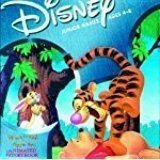Release date(s) August 28, 1995 Developer Media Station, Inc. Mode Single-player video game | Initial release date 28 August 1995 Publisher Disney Interactive | |
 | ||
Genre(s) point and click adventure, interactive storybook Series Disney's Animated Storybook Platforms Microsoft Windows, Macintosh operating systems Similar Disney's Animated Storybook games, Adventure games | ||
Disney's Animated Storybook: Winnie the Pooh and the Honey Tree is the second entry in the Disney's Animated Storybook point-and-click adventure interactive storybook PC game series, based on theatrical and home video releases. The story is based on the 1966 short film Winnie the Pooh and the Honey Tree, and the game was the first of two Animated Storybook titles based on films included in 1977's The Many Adventures of Winnie the Pooh. The game was developed by Media Station and published by Disney Interactive. It was released on August 28, 1995.
Contents
Background and development
The vision of Marc Teren, VP of entertainment for Disney Interactive, was to create games with a "true and fair representation of the original property", and aim to capitalise as "ancillary products to successful theatrical and home video releases". To achieve this, Teren helped ensure the games were animated by Disney animators. From December 1994 to February 1995, the company had hired 50 new employees. Children's Business suggests the series came into fruition because in the contemporary entertainment market, it was "customary now for entertainment companies to release CD-ROMs to support a film or TV show".
Disney and Media Station collaborated to create more than 12,000 frames of digital animation for each game, as well as 300 music and vocal clips. Digital music and sound effects were composed, orchestrated, arranged, edited, mixed and synchronized at Media Station. The games had hundreds of clickable hotspots that produced animated gags, as well as many mind-challenging interactive games. The voice cast sometimes consisted of actors from the films reprising their roles; meanwhile, at other times voice soundalikes were used.
Promotion
Winnie the Pooh and the Honey Tree was demonstrated at the 1995 Consumer Electronics Show (CES). The game's release was part of a year-long, company-wide celebration of Disney's Winnie the Pooh franchise, which included cross-promotion with Disney Interactive, Disney Licensing, Buena Vista Home Video, Walt Disney Records and Disney Press. Purchases of Toddler, Preschool, or Kindergarted Winnie the Pooh video games resulted in a free copy of Winnie the Pooh and the Honey Tree. The game was part of a "comprehensive advertising campaign in trade and consumer publications targeting family and home PC audiences". Sunday Mirror and Nestle offered tickets for a free demo CD of the game; customers had to collect two tickets and pick up the CD from Tesco branches.
Reception
Together, The Lion King and Winnie the Pooh In the Honey Tree grossed between $1 million and $2 million in the fourth quarter of 1994.
Allgame gave Winnie the Pooh and the Honey Tree a score of 3.5/5 stars. The Mirror called the game "delightful", "film-quality", and "colorful", while suggesting that young players would be "entranced" by the animated storybook. Knight Ridder Tribune said the game's "lush animation" suceeded in "capturing the warm and fuzzy texture" of the source material, and commented that despite the Winnie-the-Pooh franchise's "omnipresent commercial persona", the game would be "pure honey" to children and parents alike. The Columbian writer Mike Langberg wrote that the game "faithfully reproduces the story, visual style, voices and music" of the short. The Beacon News reported that a three year old girl "already knows more about computers than people several times her age" because the game reads to her and lets her interact with the story.
